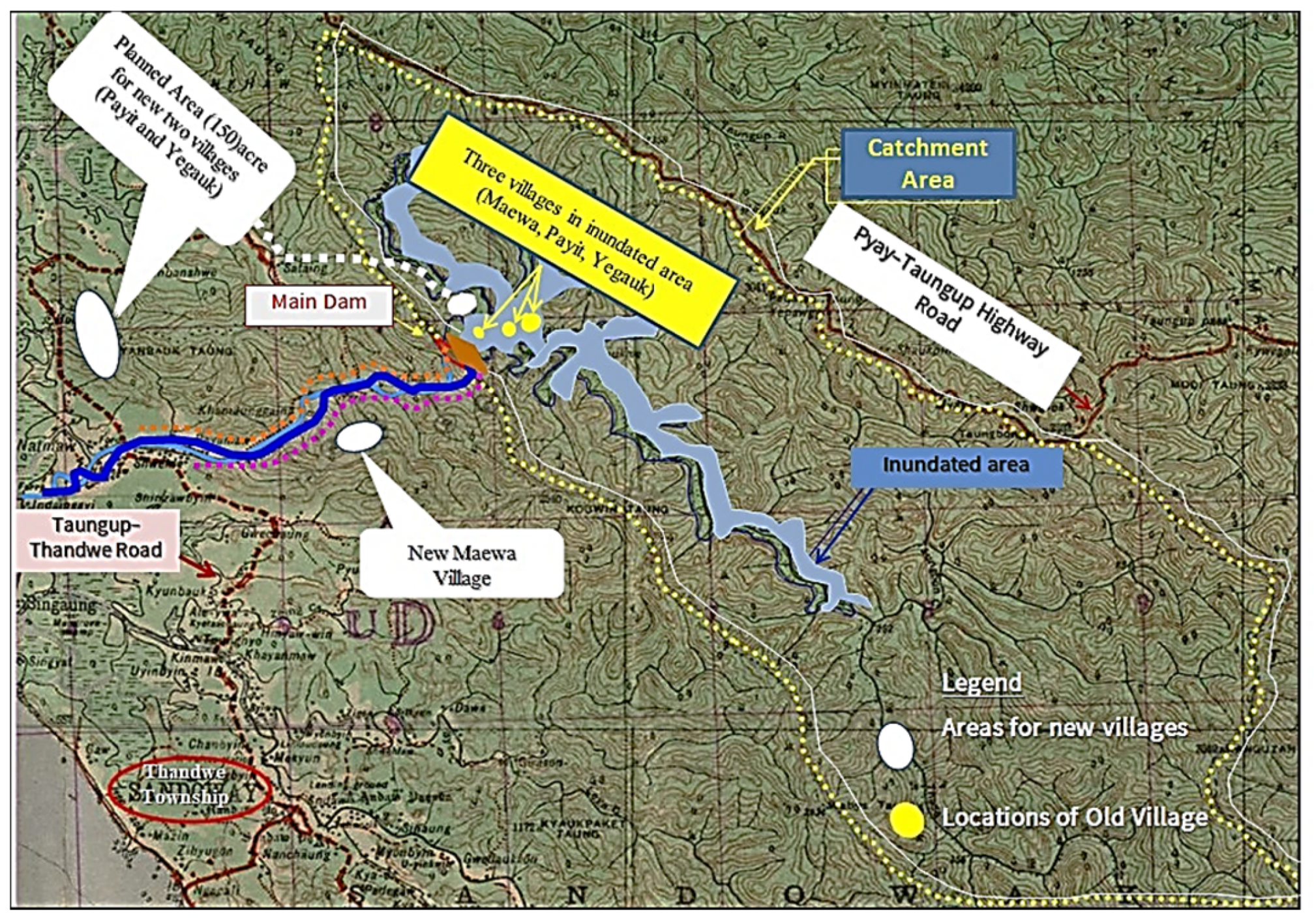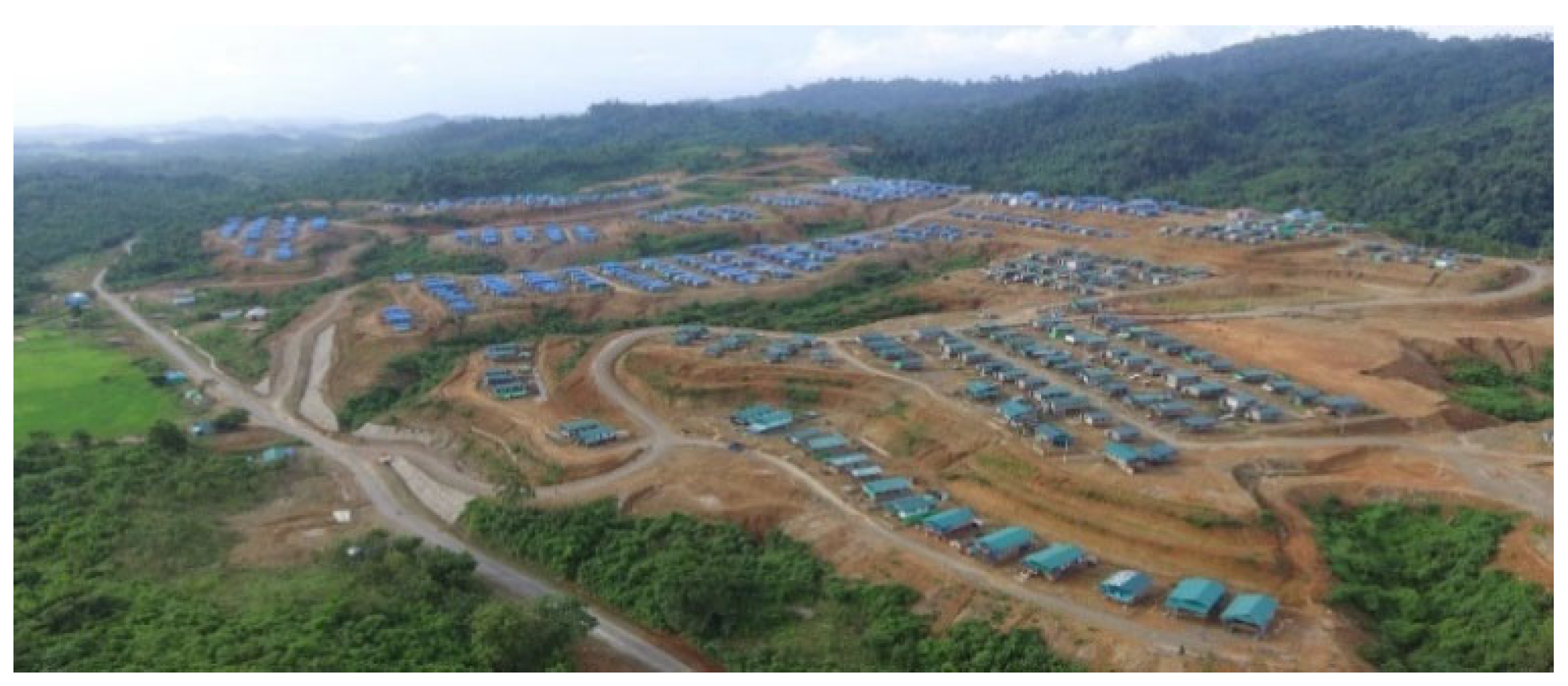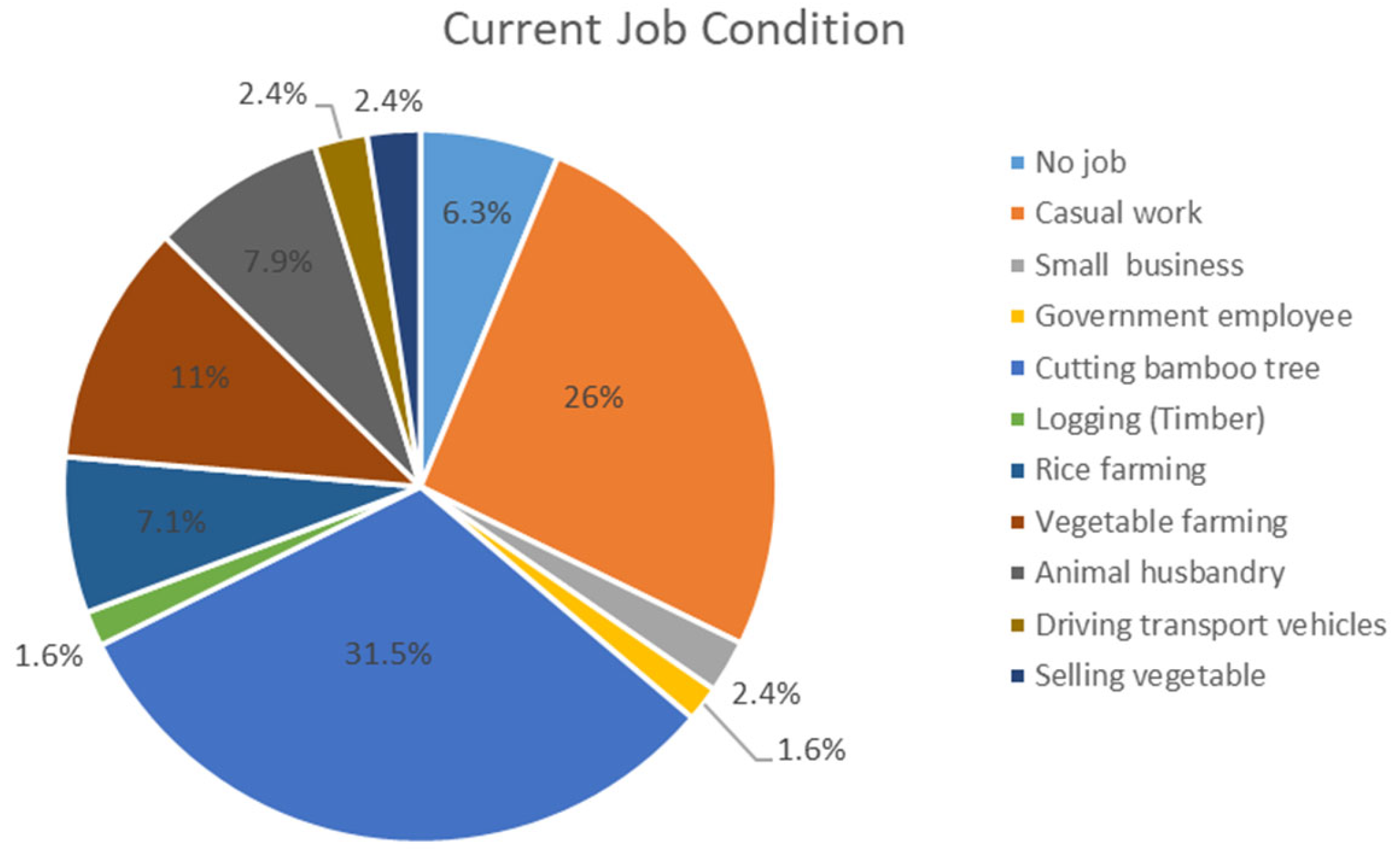Myanmar’s Planned Resettlement and Social Impact: An Empirical Case Study †
Abstract
:1. Introduction
2. Tha Htay Hydropower Project and Its Regional Context
3. Research Methodology
4. Findings and Discussion
4.1. Background Information of Respondents
4.2. Social Impacts on Resettled People from Resettlement
5. Recommendation and Conclusions
Author Contributions
Funding
Institutional Review Board Statement
Informed Consent Statement
Data Availability Statement
Acknowledgments
Conflicts of Interest
References
- Gillian Cornish. Women & Resettlement: A Case Study on Gender Aspects at the Upper Paunglaung Hydropower Dam. A Briefer of Spectrum Sustainable Development Knowledge Network. 2018. Available online: https://www.spectrumsdkn.org/en/home/other-sectors/gender/womens-empowerment/303-t-the-upper-paunglaung-hydropower-dam (accessed on 10 June 2022).
- Kattelus, M.; Rahaman, M.M.; Varis, O. Myanmar under reform: Emerging pressures on water, energy and food security. Nat. Resour. Forum 2013, 38, 85–98. [Google Scholar] [CrossRef]
- Hao, C. Study on evaluation method for sustainable development of reservoir resettlement based on analytic hierarchy process. Adv. Mater. Res. 2014, 962–965, 2195–2200. [Google Scholar]
- International Finance Corporation. Environmental and Social Impact Assessment Guidelines for Hydropower Projects in Myanmar; IFC: Washington, DC, USA, 2019. [Google Scholar]
- International Finance Corporation. Handbook for Preparing a Resettlement Action Plan; Environmental and Social Development Department; IFC: Washington, DC, USA, 2002. [Google Scholar]
- Schmitt-Degenhardt, S. A Regional Perspective on Poverty in Myanmar, UNDP, 2013. Available online: https://www.undp.org/sites/g/files/zskgke326/files/migration/mm/UNDP_MM_PvR_RegionalPovertyReport.pdf (accessed on 1 November 2022).
- Wachenfeld, M.; Yee, H.W.; Oo, M.B.; Bowman, V.; Guest, D. Myanmar’s Land Acquisition, Resettlement and Rehabilitation Law 2019—One Step Forward, Two Steps Back? 2020. Available online: https://www.semanticscholar.org/paper/Myanmar%E2%80%99s-Land-Acquisition%2C-Resettlement-and-Law-%E2%80%93-Wachenfeld-Yee/6846e443f7f60d35d25a95f3897299f7a3a1b7c0 (accessed on 14 November 2022).
- Liu, X.-F.; Song, T.-T. The sustainable livelihoods research of reservoir resettlement in the upper reaches of the Yellow River based on the development of human capital. In Proceedings of the 3rd International Conference on Education, Kuala Lumpur, Malaysia, 20–22 April 2017. [Google Scholar]
- International Finance Corporation. Strategic Environmental Assessment of Hydropower Sector in Myan mar; Baseline Assessment Report Hydropower; IFC: Washington, DC, USA, 2017. [Google Scholar]
- Evrard, O.; Guodineau, Y. Planned resettlement, unexpected migrations and cultural trauma in Laos. Dev. Chang. 2004, 35, 937–962. [Google Scholar] [CrossRef]
- Gautam, K.; Dangol, S. Developing a Resettlement Plan for the People Displaced by Budi Gandaki Hydroelectric Project. In Proceedings of the International Workshop on Role of Lnad Professionals and SDI in Disaster Risk Reduction: In the context of Post 2015 Nepal Earthquake, Kathmandu, Nepal, 25–27 November 2015. [Google Scholar]





| Time | Project Progressing Condition |
|---|---|
| April 2004 | Preliminary survey measurements were conducted for the development of the 111 MW Tha Htay Hydropower Project. |
| December 2004 | Myanmar Government approved the Tha Htay Hydropower Project to be implemented. |
| June 2005 | The detailed measurements from the selected dam locations were conducted. After that, location of the dam was confirmed. |
| April 2008 | Construction work of the project started. The inventory of the villages of Maewa, Payit and Yegauk was collected. |
| March 2009 | Maewa Village was relocated to a new location. |
| March 2014 | The statistics of the three villages collected in 2008 were compiled again. |
| January 2015 | Maewa households were first compensated for the rebuilding cost of their houses and the properties they lost. |
| March 2016 | The project-affected people from Payit and Yegauk were compensated for their losses, such as farmlands, garden land, perennial plants and so forth, except household compensation. |
| March 2020 | The resettlement area for Payit and Yegauk was approved by the regional government. |
| October 2020 | The inventory of the remaining two villages to be relocated was made again. Clearing the resettlement area for housing plot and road building. |
| March 2021 | The first batch of housing compensation was given to some households from the villages of Payit and Yegauk, and 75 households from Yegauk and 153 households from Payit were relocated to the proposed resettlement area. |
| April 2021 | The remaining 233 households from Yegauk Village moved to the resettlement area. |
| November 2022 | 73% of the whole project work has been completed but resettlement work will be complete in late 2023, except rehabilitation work. |
| 2025-2026 fiscal year | Project commissioning is expected, but it depends on the union budget allocation |
| Items | Maewa Village | Payit Village | Yegauk Village | Total |
|---|---|---|---|---|
| Household | 39 | 153 | 308 | 500 |
| Population | 166 | 433 | 992 | 1591 |
| Monastery | 1 | 1 | 1 | 3 |
| Basic Education School | - | 1 | 1 | 2 |
| Rural Health Care Centre | 1 | 1 | 1 | 3 |
| Farmland(ac) | 49.62 | 52.67 | 74.33 | 176.62 |
| Upland(ac) | 64.09 | 39.92 | 130.07 | 234.08 |
| Garden Land(ac) | 48.6 | 55.2 | 76.1 | 197.9 |
| Garden Land in the protected Forest(ac) | 26.3 | 26 | 17 | 69.3 |
| Description | Frequency | Percent (%) | |
|---|---|---|---|
| Gender | Male | 59 | 46.5 |
| Female | 68 | 53.5 | |
| Total | 127 | 100 | |
| Age (years) | 16–36 | 52 | 41 |
| 37–56 | 48 | 37.7 | |
| 57–86 | 27 | 21.3 | |
| Total | 127 | 100 | |
| Education | Illiterate | 72 | 56.7 |
| Primary school level | 42 | 33.1 | |
| Middle school level | 8 | 6.3 | |
| High school level | 2 | 1.6 | |
| University level | 2 | 1.6 | |
| Graduated | 1 | 0.8 | |
| Total | 127 | 100 | |
| Questionnaires | Mean | Std. Deviation |
|---|---|---|
| Are you satisfied with the current resettled area selection? | 3.2 | 1.011 |
| Are you satisfied with housing provided? | 3.55 | 0.879 |
| Are you satisfied with the electricity condition at your home? | 3.78 | 0.453 |
| Are you satisfied with educational facilities provided and children’s education development? | 4.02 | 0.251 |
| Do you agree that your health care condition is better, compared to previous condition? | 3.9 | 0.433 |
| Do you agree that you feel socially secure here? | 3.5 | 0.899 |
| Are you satisfied with people’s participation in the resettlement process? | 3.56 | 0.823 |
| Are you satisfied with compensation rate allocation? | 3.66 | 0.779 |
| Are you satisfied with present working opportunities? | 3.02 | 1.0 |
Disclaimer/Publisher’s Note: The statements, opinions and data contained in all publications are solely those of the individual author(s) and contributor(s) and not of MDPI and/or the editor(s). MDPI and/or the editor(s) disclaim responsibility for any injury to people or property resulting from any ideas, methods, instructions or products referred to in the content. |
© 2023 by the authors. Licensee MDPI, Basel, Switzerland. This article is an open access article distributed under the terms and conditions of the Creative Commons Attribution (CC BY) license (https://creativecommons.org/licenses/by/4.0/).
Share and Cite
Lin, A.T.; Yao, K. Myanmar’s Planned Resettlement and Social Impact: An Empirical Case Study. Environ. Sci. Proc. 2023, 25, 6. https://doi.org/10.3390/ECWS-7-14205
Lin AT, Yao K. Myanmar’s Planned Resettlement and Social Impact: An Empirical Case Study. Environmental Sciences Proceedings. 2023; 25(1):6. https://doi.org/10.3390/ECWS-7-14205
Chicago/Turabian StyleLin, Aung Tun, and Kaiwen Yao. 2023. "Myanmar’s Planned Resettlement and Social Impact: An Empirical Case Study" Environmental Sciences Proceedings 25, no. 1: 6. https://doi.org/10.3390/ECWS-7-14205
APA StyleLin, A. T., & Yao, K. (2023). Myanmar’s Planned Resettlement and Social Impact: An Empirical Case Study. Environmental Sciences Proceedings, 25(1), 6. https://doi.org/10.3390/ECWS-7-14205







